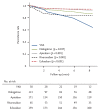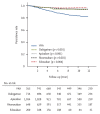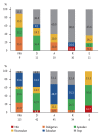A prospective survey of the persistence of warfarin or NOAC in nonvalvular atrial fibrillation: a COmparison study of Drugs for symptom control and complication prEvention of Atrial Fibrillation (CODE-AF)
- PMID: 31014064
- PMCID: PMC6960047
- DOI: 10.3904/kjim.2017.415
A prospective survey of the persistence of warfarin or NOAC in nonvalvular atrial fibrillation: a COmparison study of Drugs for symptom control and complication prEvention of Atrial Fibrillation (CODE-AF)
Abstract
Background/aims: Efforts to reduce stroke in patients with atrial fibrillation (AF) have focused on increasing physician adherence to oral anticoagulant (OAC) guidelines; however, the high early discontinuation rate of vitamin K antagonists (VKAs) is a limitation. Although non-VKA OACs (NOACs) are more convenient to administer than warfarin, their lack of monitoring may predispose patients to nonpersistence. We compared the persistence of NOAC and VKA treatment for AF in real-world practice.
Methods: In a prospective observational registry (COmparison study of Drugs for symptom control and complication prEvention of Atrial Fibrillation [CODE-AF] registry), 7,013 patients with nonvalvular AF (mean age 67.2 ± 10.9 years, women 36.4%) were consecutively enrolled between June 2016 and June 2017 from 10 tertiary hospitals in Korea. This study included 3,381 patients who started OAC 30 days before enrollment (maintenance group) and 572 patients who newly started OAC (new-starter group). The persistence rate of OAC was evaluated.
Results: In the maintenance group, persistence to OAC declined during 6 months, to 88.3% for VKA and 95.5% for NOAC (p < 0.0001). However, the persistence rate was not different among NOACs. In the new-starter group, persistence to OAC declined during 6 months, to 78.9% for VKA and 92.1% for NOAC (p < 0.0001). The persistence rate was lower for rivaroxaban (83.7%) than apixaban (94.6%) and edoxaban (94.1%, p < 0.001). In the new-starter group, diabetes, valve disease, and cancer were related to nonpersistence of OAC.
Conclusion: Nonpersistence was significantly lower with NOAC than VKA in both the maintenance and new-starter groups. In only the new-starter group, apixaban or edoxaban showed higher persistence rates than rivaroxaban.
Keywords: Anticoagulants; Apixaban; Atrial fibrillation; Dabigatran; Rivaroxaban.
Conflict of interest statement
No potential conflict of interest relevant to this article was reported.
Figures




Similar articles
-
Drug Utilization Pattern of Oral Anticoagulants in Patients with Atrial Fibrillation: A Nationwide Population-Based Study in Korea.Adv Ther. 2022 Jul;39(7):3112-3130. doi: 10.1007/s12325-022-02151-z. Epub 2022 May 7. Adv Ther. 2022. PMID: 35524839 Clinical Trial.
-
Therapy persistence in newly diagnosed non-valvular atrial fibrillation treated with warfarin or NOAC. A cohort study.Thromb Haemost. 2016 Jan;115(1):31-9. doi: 10.1160/TH15-04-0350. Epub 2015 Aug 6. Thromb Haemost. 2016. PMID: 26246112
-
[Real-world adherence to oral anticoagulants in atrial fibrillation].Orv Hetil. 2020 May 1;161(20):839-845. doi: 10.1556/650.2020.31727. Orv Hetil. 2020. PMID: 32364687 Hungarian.
-
Non-vitamin K antagonist oral anticoagulants in cardiovascular disease management: evidence and unanswered questions.J Clin Pharm Ther. 2014 Apr;39(2):118-35. doi: 10.1111/jcpt.12122. Epub 2014 Jan 3. J Clin Pharm Ther. 2014. PMID: 24383983 Review.
-
Oral anticoagulant therapy in atrial fibrillation patients at high stroke and bleeding risk.Prog Cardiovasc Dis. 2015 Sep-Oct;58(2):177-94. doi: 10.1016/j.pcad.2015.07.003. Epub 2015 Jul 7. Prog Cardiovasc Dis. 2015. PMID: 26162958 Review.
Cited by
-
Patient characteristics, adherence, and costs of oral anticoagulation therapy in non-valvular atrial fibrillation using the Dubai Real-World Claims Database.Avicenna J Med. 2021 Apr 19;11(2):93-102. doi: 10.4103/ajm.ajm_228_20. eCollection 2021 Apr-Jun. Avicenna J Med. 2021. PMID: 33996647 Free PMC article.
-
2021 Focused update of the 2017 consensus guidelines of the Asia Pacific Heart Rhythm Society (APHRS) on stroke prevention in atrial fibrillation.J Arrhythm. 2021 Nov 13;37(6):1389-1426. doi: 10.1002/joa3.12652. eCollection 2021 Dec. J Arrhythm. 2021. PMID: 34887945 Free PMC article.
-
Comparison of Early Complications of Oral Anticoagulants after Totally Thoracoscopic Ablation: Warfarin versus Non-vitamin K Antagonist Oral Anticoagulants.J Chest Surg. 2023 Mar 5;56(2):90-98. doi: 10.5090/jcs.22.081. Epub 2023 Jan 30. J Chest Surg. 2023. PMID: 36710581 Free PMC article.
-
Comparison of warfarin, rivaroxaban, and dabigatran for effectiveness and safety in atrial fibrillation patients with different CHA2DS2-VASc scores: a retrospective cohort study.BMC Cardiovasc Disord. 2024 Jul 16;24(1):361. doi: 10.1186/s12872-024-04020-9. BMC Cardiovasc Disord. 2024. PMID: 39014359 Free PMC article.
-
The difference of burden of ectopic beats in different types of atrial fibrillation and the effect of atrial fibrillation type on stroke risk in a prospective cohort of patients with atrial fibrillation (CODE-AF registry).Sci Rep. 2020 Apr 14;10(1):6319. doi: 10.1038/s41598-020-63370-4. Sci Rep. 2020. PMID: 32286428 Free PMC article.
References
-
- January CT, Wann LS, Alpert JS, et al. 2014 AHA/ACC/HRS guideline for the management of patients with atrial fibrillation: a report of the American College of Cardiology/American Heart Association Task Force on practice guidelines and the Heart Rhythm Society. Circulation. 2014;130:e199–e267. - PMC - PubMed
-
- Kim TH, Yang PS, Uhm JS, et al. CHA(2)DS(2)-VASc score (congestive heart failure, hypertension, age ≥75 [doubled], diabetes mellitus, prior stroke or transient ischemic attack [doubled], vascular disease, age 65-74, female) for stroke in Asian patients with atrial fibrillation: a Korean nationwide sample cohort study. Stroke. 2017;48:1524–1530. - PubMed
-
- Hart RG, Pearce LA, Aguilar MI. Meta-analysis: antithrombotic therapy to prevent stroke in patients who have nonvalvular atrial fibrillation. Ann Intern Med. 2007;146:857–867. - PubMed
-
- Connolly SJ, Ezekowitz MD, Yusuf S, et al. Dabigatran versus warfarin in patients with atrial fibrillation. N Engl J Med. 2009;361:1139–1151. - PubMed
Publication types
MeSH terms
Substances
LinkOut - more resources
Full Text Sources
Medical
